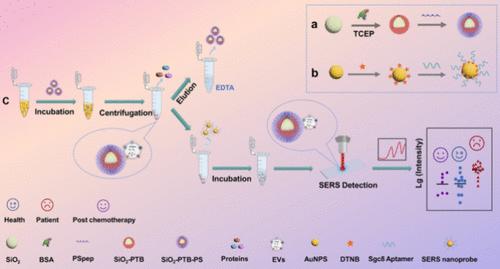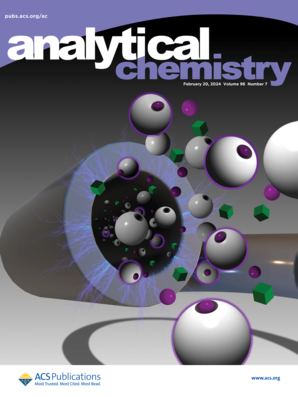IF 6.7
1区 化学
Q1 CHEMISTRY, ANALYTICAL
引用次数: 0
摘要
细胞外囊泡(EVs)是各种生理和病理过程中的重要介质,可促进细胞间的交流,并具有作为疾病诊断标志物的潜力。然而,现有的 EVs 分离方法存在局限性,阻碍了其临床应用。在本研究中,我们提出了一种使用双功能二氧化硅微球(SiO2-PTB-PS)从复杂生物介质中特异性、无损地分离 EVs 的新方法。随后,分离出的 EVs 被用于直接检测临床样本中的癌症。SiO2-PTB-PS微球具有磷脂酰丝氨酸(PS)识别肽(PSpep)的功能,能与EVs表面的PS特异性结合。此外,硅胶微球上的防粘涂层最大程度地减少了蛋白质污染,提高了纯度。这种基于亲和力的识别和防污策略确保了高纯度的 EVs 分离。此外,我们还开发了一种检测系统,将SiO2-PTB-PS微球与表面增强拉曼散射(SERS)纳米探针相结合,用于识别EVs膜上的蛋白酪氨酸激酶7(PTK7)和上皮细胞粘附(EpCAM),在区分癌症患者和健康供体方面达到了80%的精确度。SiO2-PTB-PS 微球系统作为一种生物技术工具显示出巨大的前景,推动了基于 EVs 诊断的临床应用。本文章由计算机程序翻译,如有差异,请以英文原文为准。

Extracellular Vesicles Separation and Biomedical Application Based on Affinity Recognition and Antifouling Coating Bifunctional Microsphere
Extracellular vesicles (EVs) are crucial mediators in various physiological and pathological processes, facilitating intercellular communication and offering potential as diagnostic disease markers. However, existing EVs separation methods have limitations that hinder their clinical application. In this study, we present a novel approach using bifunctional silica microspheres (SiO2-PTB-PS) for the specific, nondestructive isolation of EVs from complex biological media. The isolated EVs were subsequently used for direct cancer detection in clinical samples. The SiO2-PTB-PS microspheres, functionalized with a phosphatidylserine (PS) recognition peptide (PSpep), specifically bound to PS on the EVs surface. Additionally, an anti-adhesion coating on the silica microspheres minimized protein contamination, enhancing purity. This affinity-based recognition and antifouling strategy ensured high-purity EVs separation. Furthermore, we developed a detection system combining SiO2-PTB-PS microspheres with surface-enhanced Raman scattering (SERS) nanoprobes to identify protein tyrosine kinase 7 (PTK7) and epithelial cell adhesion (EpCAM) on the EVs membrane, achieving 80% precision in distinguishing cancer patients from healthy donors. The SiO2-PTB-PS microsphere system shows significant promise as a biotechnology tool, advancing the clinical application of EVs-based diagnostics.
求助全文
通过发布文献求助,成功后即可免费获取论文全文。
去求助
来源期刊

Analytical Chemistry
化学-分析化学
CiteScore
12.10
自引率
12.20%
发文量
1949
审稿时长
1.4 months
期刊介绍:
Analytical Chemistry, a peer-reviewed research journal, focuses on disseminating new and original knowledge across all branches of analytical chemistry. Fundamental articles may explore general principles of chemical measurement science and need not directly address existing or potential analytical methodology. They can be entirely theoretical or report experimental results. Contributions may cover various phases of analytical operations, including sampling, bioanalysis, electrochemistry, mass spectrometry, microscale and nanoscale systems, environmental analysis, separations, spectroscopy, chemical reactions and selectivity, instrumentation, imaging, surface analysis, and data processing. Papers discussing known analytical methods should present a significant, original application of the method, a notable improvement, or results on an important analyte.
 求助内容:
求助内容: 应助结果提醒方式:
应助结果提醒方式:


